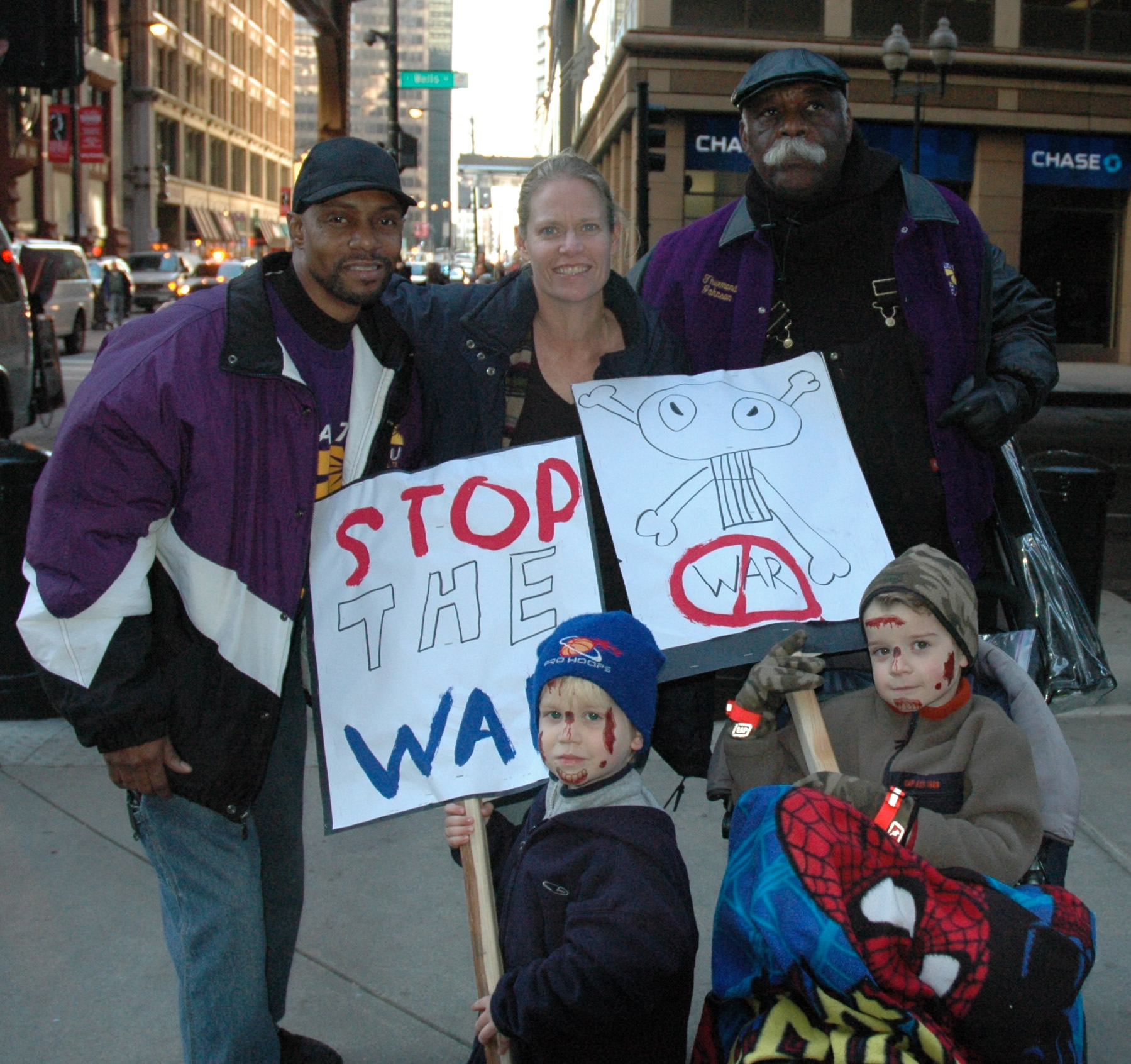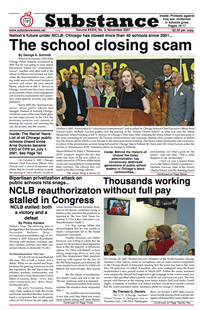SDS tries 'militancy' in separate October 27 march against Middle East wars

Opposition to collaboration with Democrats beginning, amidst confusion
There were actually two marches in Chicago on October 27, and I spent most of my time at the smaller one, organized by the new “Students for a Democratic Society” (SDS) to see what was being organized as an alternative to the Democratic Party.
Here are some notes and thoughts from the SDS feeder march to the Oct. 27th antiwar march in Chicago touching on creating connections w/ larger working class daily-life issues:
Politically disgusted by the Democratic Party rally planned for the main event of the day, I joined an SDS feeder march that walked and chanted through the busy downtown shopping area. About 60 strong and mostly college students, we started at a military recruiting office in the south end of the Loop and marched on the sidewalk down the main shopping street, with chants and banners. During our march, I flashed back to the early days of the anti war movement here when the Chicago Committee To End the War held antiwar speakouts, marches, and sit- ins and got arrested on those same streets. This, of course, was different.
One of the chants was, “Bombs are dropping while you’re shopping !”
I went up to one guy who was particularly emphatic and asked him, “Do you think all these people are our enemy?”
His answer, “Yes, they’re the good Germans. If they’re not with us, they’re against us.”
Trying to get him to consider the possibility of seeing potential allies who we needed to reach, I asked him, “Did you think this way when you were 12?”
Instead of answering, he responded, “ All they care about is shopping and their personal lives.”
So I asked him, “How can we relate to the guy I met on the train coming here? He’s 68, has to work till he dies, doesn’t have good medical coverage and hates Bush and this war, so how do we relate to him and the millions like him?”
His response was something like, “You get him; I’ll chant.” Meaning, drop it.
I asked two women near me what they thought of this chant, and they each said they didn’t agree with it. The next time we started using it, one of them went over and spoke to the person with the bullhorn, who then stopped chanting it.
Later, as we crossed the Kennedy Expressway, several marchers stopped for a minute to hold up their antiwar signs. Quite a few drivers honked in support, some of us cheered that, and the guy I originally engaged smiled and flashed the peace sign. We then proceeded down Randolph in a recently-gentrified area filled with more expensive restaurants. Several of the marchers in front of me flashed peace signs to the people inside, some of whom returned them to us, including waitstaff. One of the people doing it was the same guy. The most repeated SDS chant went like this, “War and occupation will never bring liberation. It’s bullshit! Get over it! This war is for profit.”
Later that night, talking it over with my partner Sue, she said she agreed with him, the guy who saw shoppers as self-centered, saying that “Our culture is totally self-centered consumerism.” Of course, that’s true too. What do you think? Is there any connection besides, “Money for healthcare, not warfare!”, a popular sign and slogan. How do we connect the daily life issues with the war in a way to bring out the forces to actually force change?
As we marched down Randolph, some cops took down one of the marchers. While I didn’t see what started it, the cops were hard on him, eventually using a taser according to a friend who was right there. After that, in the uproar, most of us pushed against a quickly-drawn up police line of the maybe 10 bicycle cops assigned to us. Yelling, “Let him go!” and pushing, it came very close to an all-out brawl. We weren’t large enough to take him back, and I said so to several around me. We didn’t push through, and the cops arrested two more who were still angry and maybe had pushed or shoved by themselves.
After some hurried street discussions, we continued on, with some staying to keep up with our comrades in police hands.
Talking it over with another marcher was interesting. He agreed that we shouldn’t have tried to get our guy back, having been in last year’s SDS demo with some anarchists in D.C. There, they’d broken through police lines to cross a bridge with about 1,000 marchers who’d been prepared and had shields to protect themselves from the cops’ clubs and tasers. After breaking through, they were met by a line of what he called Pentagon police, with shields, weapons and lined up shoulder-to-shoulder. The marchers then sat down in the street and conducted an open discussion over what to do. As the police gatherer more numbers and prepared to march into them, they decided to retreat and did so in an orderly way.
(This reminded me of a similar event, back, I think, in 1964 or ‘65, called the Assembly of Unrepresented People, a weekend conference of mostly northern white antiwar activists and southern black civil rights activists. The main idea was that the government — with a Democratic president and Congress — did not represent us, and was, in fact, our common opponent. We met in workshops to share experiences and ideas, with the aim of building greater unity, although many of the antiwar activists were themselves former civil rights activists. Certainly we — antiwar activists — were all profoundly moved and formed by that movement and its struggles. In any case, we marched to present a statement of opposition when a line of D.C. cops blocked us. We too, led by radical pacifists, sat down and held a town-hall type meeting where anyone was free to say who they were, why they were there and what, if anything, they thought we should do. It was amazing, touching and a powerful example of how a radical democratic outlook could tap into and help create a collective sense of ‘we’. The cops attacked us as we sat there, arresting any and everyone they could literally get their hands on, lying in court later to the judges’ solemn agreement, but that’s another story.)
Back to the SDS march on October 27, 2007.
The same fellow telling me about their D.C. experience was from DePaul, so I asked him if the campus group that had fought for Prof. Finkelstein and academic freedom still existed. Very interesting. Turns out that the Conservative Alliance infiltrated provocateurs to disrupt the group, start e-mail fights, and just wreck things. They largely succeeded, although the hard-core activists did retreat and set up a smaller, closed group which still does exist and is active on campus.
Since I had seen some left groups at the last demonstration for Finkelstein’s job and against his being fired for his views on Israel and the Holocaust industry, I asked him how that was going. He was very harsh against left groups (he named Spartacists and others) which, according to him, jumped into every meeting with freshmen and attacked the freshmen’s, ideas about capitalism, socialism, etc. This, he said, made it very hard to reach these freshmen about the issues of the day.
Of course, I wasn’t there. Also, this person may be opposed to having any such discussions and want to keep everything single- issue, on academic freedom; I don’t know. Still, for those who are opposed to capitalism and who believe, with Marx, that another world is indeed possible, how should we raise our ideas in this context?
(My formative experience was partly in SDS, where the PLP did participate in building antiwar action and ideas on campus while raising their ideas on how to make a worker-student alliance based on class issues. Some hated it, others loved it as a strategic outlook, but we grew from three to an organized group of about 1,000. I raise this not to renew old arguments, but to suggest that it is possible to do both- build particular struggles and raise revolutionary ideas with immediately practical and theoretically-relevant ways).
We ended our feeder march at Union Park after about three miles. There were a few thousand people in the park, in good spirits from response to the speakers and entertainers, almost all white except for a contingent of maybe 100-150 black high school students, mostly holding ‘World Can’t Wait’ banners and marching with the smaller contingent from The Woodlawn Organization, a major real estate player on the South Side which has deep and long ties to the Daley administration. That was the only sign that all the Democratic Party speakers had any organized base of support.
I was tired after that march and another of two miles to get to the train to the city, so I took the El back downtown and met the crowd as it came to the Federal Building, standing on the sidewalk and watching them go by. Usually, veterans for peace groups lead the march. Here, I did not see an Iraqi Vets Against the War contingent although there were a few banners identified as Veterans for Peace.
The entire group marched for 20 minutes, with rough lines of about 15 across the street. I’d say that’s maybe 5-7,000 of us. Energetic, good spirits, many chants, mostly white and kids to old folks. I only saw one union banner, the Steelworkers, that said, “ Keep the Jobs HERE; Bring the Troops HOME!” with maybe 15-20 mostly older people behind it. No immigrants’ rights groups that I saw, except for the Woodlawn org contingent, no Black groups against police brutality, etc.
I stayed a while at the downtown rally, long enough to hear several city aldermen introduced as if they were some great leaders and mouth empty generalities while they didn’t mention their Party’s actual record. Like the massive immigrants’ rights rallies before, this showcased the liberal Democrats as if they are the path to peace. Is this a death wish or just the blind leading the blind?! It reminded me of the same crowd urging the antiwar movement to ‘cool it’ so as not to embarrass John Kerry in his run against Bush in ’04. Of course, we were supposed to forget that Kerry openly stood for adding 40,000 troops and ‘staying the course’ in Iraq!
Now, after showing their true colors, the Democratic- majority Congress ranks lower in polls than Bush. I’m told by antiwar activists who know that the planning for this rally was held by invitation only, that only those who agree with United for Peace and Justice’s and the Communist Party’s emphasis on the Democrats set it up. Still, this crowd pushes the same old tired line — look to the Democrats. Lobby them. "Hold their feet to the fire". How? By putting them on stage with their empty rhetoric while their party helps Bush fund and fight the war they endorsed?
The challenge is, how do we build the alternative? Not just to the Democrats politically, but also connect the many separate threads of resistance into one garment of power?
Your thoughts, experiences and ideas are welcome; I’ll forward them for others. Red1Pearl@aol.com.



